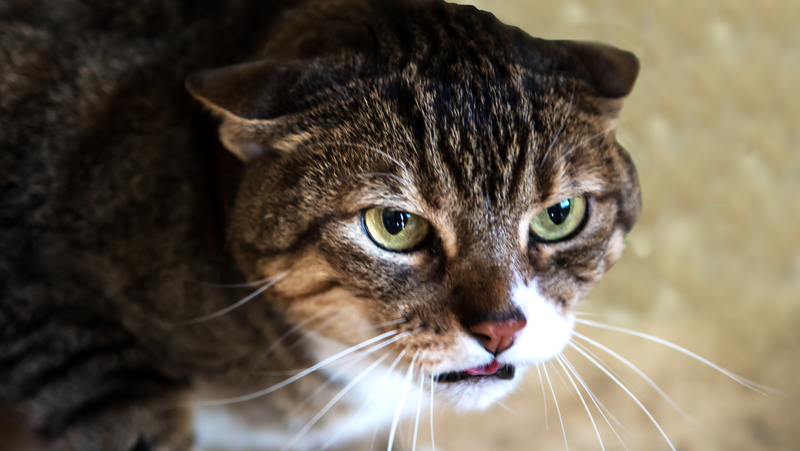My Pet World: Neighbor’s Cat Becomes Seriously Mean
Plus a picky pooch and other dog food questions

In this edition of My Pet World, animal expert Cathy M. Rosenthal responds to a woman whose neighbor’s cat suddenly becomes mean – the friendly feline’s sudden change in behavior leaves the woman heartbroken – as well as dog food questions and a picky pooch.
Dear Cathy,
My neighbor adopted a pair of kittens a couple of years ago. I have periodically taken care of them when she goes away for work. I also have clipped their nails. All without any concerns or problems. Unfortunately, over the last year the female has become overly aggressive when I go over and I have no idea why? When I entered the home the other day, she hissed and lunged at me and bit my thigh pretty badly. Afterward, she followed me throughout the house hissing with her ears completely flat on her head. I absolutely adore these cats and am brokenhearted over the female’s change in behavior. I have tried entering the home by placing treats on the floor. Do you have any idea what can be done so I can continue to care for these cats?
– Barbara, East Berlin, Connecticut
Dear Barbara,
That’s a very strange change in behavior for a formerly friendly feline. While age sometimes can play a role in behavior changes, she is acting more like she’s in pain. Your neighbor should get her checked out by a veterinarian to make sure she hasn’t developed a health problem.
If it’s not a health problem, then something is stressing her, either in the home or with your visits. Either way, you will need to rebuild trust with her. Buy feline pheromone spray and spray it all over yourself before you enter the house. Ask the neighbor if she will buy a pheromone collar for her female cat and a plug-in pheromone for the house. When used in combination, these products have a better calming effect.
As for your interactions, don’t touch her again unless she invites you to pet her. Keep your distance until you restore trust with her but do talk sweetly to her and continue leaving her treats. Be patient. It can take months to rebuild feline friendships.
Another cat suddenly becomes mean – this time to Grandmom
 Dear Cathy,
Dear Cathy,
I am trying to determine what kind of food to feed my dog. He is a 5-year-old male Maltese who weighs 22 pounds. How do I determine whether to feed wet or dry food?
– Gene, Virginia Beach, Virginia
Dear Gene,
Many people think dogs need variety in their diets because we as people do. But dogs will happily eat the same food every day without complaint. If your dog doesn’t require a special prescription diet for a health problem, you can feed him dry, wet, or semi-moist food or a combination of them, depending on your budget. (Wet food tends to cost more than dry food.) It’s fine, for example, to top dry food with a little wet food. Just make sure the food’s nutritional label includes the phrase “complete and balanced,” which indicates the product is nutritionally balanced and can be fed as the pet’s sole diet.
Determining what age of dog to adopt
Dear Cathy,
I have a 6-month-old Chihuahua and Maltese mix. I love him but I feel so frustrated because he doesn’t like his food. I have bought many different types of dog food and he won’t eat it. He’s current with his vaccines. What do I do?
– Marina Benitez, Bayshore, New York
Dear Marina,
Your willingness to find the right dog food for your pooch may have trained him to be a picky eater. Some dogs become fussy eaters as a result of too many table scraps, treats, or dog food options. Your dog may avoid eating dinner in the hopes of holding out for more exciting food. To reverse this, don’t feed him any table scraps (ever) or treats (temporarily) until you get him on a regular diet. Feed him twice daily when you are eating your meal. Leave the food out for 20 to 30 minutes and then remove it. This will help establish a routine. If he doesn’t eat it right away, you may worry he will starve and want to slip him a few treats. Stay strong. Your dog is not starving. While dogs can have personal preferences, they also are opportunistic eaters, which means in the wild they would eat whatever they could find. Stick to this routine and he should start to eat the food you offer him in a day or two.
Having said that, and if you have ruled out a health problem, your dog could have an allergy to certain proteins, like chicken, and so instinctively avoids certain foods. If you suspect that might be the case here, then try a “limited ingredient diet” dog food with a different protein source and follow the steps above to get him eating again.


